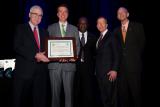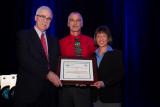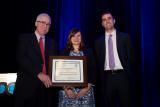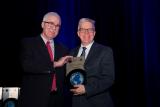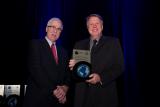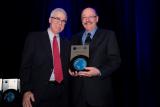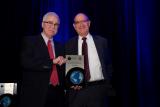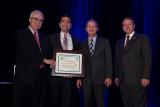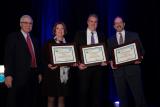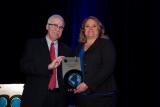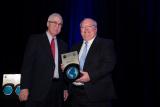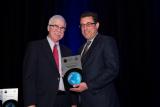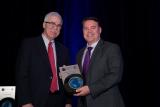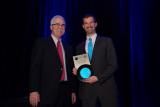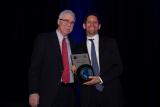2016 Climate Leadership Award Winners
 Congratulations to the 2016 Climate Leadership Award winners! One Individual, 13 Organizations, and three Partnerships were publicly recognized for their leadership in reducing greenhouse gas emissions and climate action during the awards dinner on March 9, as part of the Climate Leadership Conference, held in Seattle, WA from March 8 - 10, 2016.
Congratulations to the 2016 Climate Leadership Award winners! One Individual, 13 Organizations, and three Partnerships were publicly recognized for their leadership in reducing greenhouse gas emissions and climate action during the awards dinner on March 9, as part of the Climate Leadership Conference, held in Seattle, WA from March 8 - 10, 2016.
Read EPA's press release recognizing the awardees.
Organizational Leadership Award
Individual Leadership Award
Supply Chain Leadership
Excellence in Greenhouse Gas Management (Goal Achievement Award)
- Best Buy Co., Inc.
- Kimberly-Clark Corporation
- Pitney Bowes
- United Technologies Corporation
- Xcel Energy
Excellence in Greenhouse Gas Management (Goal Setting Certificate)
Innovative Partnerships Certificate
- The Government Authorities for the Home Energy Renovation Opportunity (HERO) Program
- King County-Cities Climate Collaboration (Washington State)
- Minneapolis Clean Energy Partnership
Special Thanks to the CLA Reviewers
Organizational Leadership Award
Recognizes organizations that not only have their own comprehensive greenhouse gas inventories and aggressive emissions reduction goals, but also exemplify extraordinary leadership in their internal response to climate change, and engagement of their peers, partners, and supply chain.
California Department of Water Resources
The California Department of Water Resources (DWR) operates and maintains the State Water Project (SWP), which supplies drinking water to over 25 million Californians and irrigation water to 750,000 acres of farmland. In addition, the SWP has 1,700 megawatts of renewable hydroelectric generation capacity, as well as provides environmental benefits and recreational opportunities. The Department also has responsibility for 1,600 miles of flood protection levees and structures, prepares the California Water Plan Update (the State’s strategic plan for water resources), administers over $1 billion in grant funds to improve regional water management, and oversees dam safety statewide.
DWR is receiving a Climate Leadership Award for Organizational Leadership. Highlights from its recent efforts include:
- Setting an absolute GHG emissions reduction goal of 33 percent from 2010 to 2020. (The Department’s GHG emissions reduction plan does not fall under the state’s AB32 regulations, and will achieve a greater percentage of reduction than required for the state as a whole.)
- Addressing climate change impacts to ensure that Californians have an adequate water supply, healthy ecosystems, and reliable flood control. DWR’s Climate Change Program Five-year Strategic Plan describes the Department’s climate change mitigation and adaptation goals with six primary objectives: communications, mainstreaming of climate analysis, support for local and regional water managers, data and research, and GHG mitigation.
- Empaneling a Climate Change Technical Advisory Group to improve the scientific basis for decisions and enhance the consistency of climate change approaches, impacts on California’s water resources, use and creation of planning approaches and analytical tools, and the development of adaptation responses.
- Supporting atmospheric research and citizen science, developing a California water-energy information framework, and assisting tribes in identifying and addressing vulnerabilities and strategies to reduce climate impacts.
- DWR also recently evaluated its 2011 Climate Change Handbook for Regional Water Planning, which is a key resource for local water planners. DWR is using these findings to improve existing tools and develop new resources to support climate change planning at the local and regional level.
- Partnering with external organizations, for example, with the University of California at Berkeley, to evaluate how urban water suppliers, regional water management groups, and regional flood planning agencies are incorporating climate change into their planning.
- DWR partnered with the California Department of Food and Agriculture, California Polytechnic State University, and the California Department of Fish and Wildlife to launch a public awareness campaign on climate change impacts on agriculture and food.
- Additional partners include the Scripps Institution of Oceanography’s Center for Western Weather and Water Extremes, to develop characterizations of past, present, and future atmospheric river events and improved forecasting; the California Landscape Conservation Cooperative (including serving as Steering Committee Chair); and the Netherlands National Water Resources Management agency.
- Educating water managers, the general public, and over 200 employees on climate change issues impacting water resources. Additional public engagement includes citizen science programs and climate science and water workshops for K-12 teachers.
DWR was previously recognized with a Climate Leadership Award in 2015 for Excellence in Greenhouse Gas Management—Goal Setting.
Ingersoll Rand is a global industrial manufacturing company that provides products and services to enhance the quality and comfort of air in homes and buildings; transport and protect food and perishables; and increase industrial productivity and efficiency. Revenue is generated primarily through the design, manufacture, sale and service of brands including Club Car, Thermo King, Trane, and Ingersoll Rand. The company has more than 40,000 employees and more than 60 manufacturing sites around the world.
Ingersoll Rand is receiving a Climate Leadership Award for Organizational Leadership. Highlights from its recent efforts include:
- Setting a GHG emissions reduction goal of 35 percent from 2013 by 2020 for global operations.
- Establishing a climate commitment that encompasses the company's entire product portfolio and includes refrigerant and energy efficiency initiatives. The company has committed to reduce the climate impact related to the refrigerant used in the company's products by 50 percent by 2020 and incorporating lower global warming potential refrigerant alternatives across the product portfolio by 2030.
- Using Life Cycle Assessments (LCAs) in its product development process to identify areas of high environmental impact which can then be addressed directly. To date, products with LCAs account for over $870 million USD of revenue.
- Reducing energy and emissions in its fleet via vehicle replacement to more fuel efficient vehicles, rationalization, inventory management, and specification changes.
- Creating EcoWise™, a portfolio of products designed to lower environmental impact with next generation, low global warming potential refrigerants and high efficiency operation.
- Collaborating with external organizations, including the Institute for Governance & Sustainable Development on: 1) the 2003 Industry Genius book, 2) the 2007 Adjustment to the Montreal Protocol accelerating the HCFC phase out, and 3) the pending Amendment to the Montreal Protocol to phase down HFCs. Ingersoll Rand has also partnered with the refrigerant manufacturer Chemours® (formerly DuPont) to develop a next-generation, low-GWP refrigerant that is design-compatible with R410A and efficient and safe, and requires little engineering of current systems. Ingersoll Rand also partnered with UL Environment to develop the exclusive Design for Sustainability Certificate Program, a development opportunity targeted to engineering, product management and sourcing functions.
- Awarding a $50k grant to the National Minority Supplier Development Council in 2014 for scholarships for 20 minority-owned businesses to participate in the Centers of Excellence Program, which provides capacity building, development, and mentoring for minority business participants.
Ingersoll Rand was previously recognized with a Climate Leadership Award in 2012 for Excellence in Greenhouse Gas Management—Goal Setting.
Mars, Incorporated has been a private, family-owned company for more than 100 years. Headquartered in McLean, Virginia, Mars has more than 75,000 associates in 73 countries, and is comprised of six segments: petcare, chocolate, Wrigley, food, drinks, and symbioscience.
Mars is receiving a Climate Leadership Award for Organizational Leadership. Highlights from its recent efforts include:
- Setting an absolute GHG emissions reduction goal of 25 percent from 2007 to 2015 for global operations. The company’s future goal is to eliminate GHG emissions 100 percent by 2040.
- Implementing Sustainable in a Generation (SiG), Mars’ operations sustainability program. SiG works to achieve the company’s climate, water, and waste targets via three work streams: efficiency improvement through operational changes and capital investment; breakthrough technology, centered on finding more sustainable ways to manufacture and formulate products; and use of renewable energy. Managers deploy SiG at the site, region, business segment, and corporate levels.
- Implementing energy efficiency measures as well as increasing use of renewable energy, such as using steam generated from a waste energy facility to meet 90 percent of one site’s heating needs while lowering energy-related GHG emissions by 60 percent. Additionally, in 2015, Mars set a 20-year commitment to purchase power from a wind farm that provides the equivalent of 12 percent of the company’s global energy requirements, all its U.S. power needs, and eliminates 24 percent of its global GHG emissions.
- Launching its Deforestation Policy in 2014. The policy commits Mars to sourcing raw materials with the greatest impact on forests (beef, palm oil, pulp and paper, and soy) from producers and suppliers who comply with set standards.
- Partnering with external stakeholders such as the World Resources Institute (WRI) and taking a leading role in collaborative organizations (e.g., RE100, The Sustainability Consortium). Mars has joined leading companies to draft and sign the World Wildlife Fund and WRI’s Renewable Energy Buyers’ Principles to simplify the renewable energy market. Mars contributed to the development of the new GHG Protocol Scope 2 reporting standard and the Science Based Target setting initiative developed jointly by WRI/WWF/CDP. Additional collaboration includes University of California—Davis, University of Arkansas, and the USDA Agricultural Research Service to develop an alternate wetting and drying irrigation approach that saves water and reduces methane emissions from rice fields.
Microsoft Corporation is a leading multinational technology company for the mobile-first, cloud-first world. Microsoft is headquartered in Redmond, Washington and is best known for products including its Windows line of operating systems, Microsoft Office, Xbox, Skype and Outlook.
Microsoft is receiving a Climate Leadership Award for Organizational Leadership. Highlights from its recent efforts include:
- Setting and achieving a commitment to become carbon neutral, beginning in July 2012, for operations across 100 countries and inclusive of their data centers, software development labs, offices, and air travel. Microsoft’s first public GHG goal was set in 2007 as a 30 percent reduction by 2012 (2007 base year), which was achieved.
- Implementing an internal carbon fee to reach its carbon neutrality goal. The fee, paid by business units across the business, funds internal efficiency upgrades; Power Purchase Agreements (PPAs) and green power instruments; carbon offset projects; and supply chain engagement. These actions have funded the purchase of more than 10 billion kilowatt-hours of green power, reduced emissions by 7.5 million metric tons of carbon dioxide equivalent and had an impact on more than six million people in emerging nations through carbon offset community projects.
- Microsoft established an internal carbon fee that holds business groups financially responsible for their actions, charging for their carbon emissions and incentivizing them to reduce their overall GHG emissions. The company implemented the fee across its operations in more than 100 countries.
- Microsoft’s energy efficiency upgrades in new buildings and data centers includes measures such as outside air cooling; the use of economizers that dramatically cut energy and water used for cooling; upgraded lighting equipment; and improving and extending its e-waste recycling program.
- Microsoft also has a commitment to procuring 100 percent green power for its global operations. The company invests in Power Purchase Agreement projects where possible and purchases green power instruments such as Green-e certified RECs and Guarantees of Origin to reach the goal of 100 percent renewable electricity.
- Finally, the carbon fee supports carbon offset community projects around the globe, which also deliver benefits such as biodiversity protection, energy access, water stewardship, job creation, and low-carbon economic development.
- Requiring all suppliers to uphold the ethical business, employment, environmental, and worker safety practices in its Supplier Code of Conduct, calling for vendors to share Microsoft’s commitment to responding to challenges posed by climate change.
- Leveraging its technology solutions to increase sustainability, including using the cloud to deliver services and reduce carbon impacts; launching the CityNext initiative that brings cloud, big data, mobile, and social technologies together to deliver sustainable solutions for energy and water, transportation, and smart buildings for cities; and responsibly reusing, refurbishing, or recycling used computers and electronics from its own operations and personal and electronic items from employees.
- Leading with numerous collaborations, such as being a founding member of the Information Technology Industry Council's Digital Energy & Sustainability Solutions Campaign, and serving on the board of the Global e-Sustainability Initiative, a collaborative effort between leading IT companies and the United Nations Environmental Programme and International Telecommunication Union.
Individual Leadership Award
Recognizes individuals who demonstrate extraordinary leadership both in their internal response to climate change and through engagement of their peers, competitors, partners, and supply chain.
Thomas G. Day, United States Postal Service
Mr. Thomas Day is the Chief Sustainability Officer of the U.S. Postal Service. His 40+ year-long federal career has included numerous efforts to address climate change.
Thomas Day is receiving the Climate Leadership Award for Individual Leadership. Highlights from his recent efforts include leading the following initiatives:
- Moved the Postal Service forward on setting a GHG emissions reduction goal for USPS of 20 percent by 2020 from a base year of 2008.
- Oversaw the introduction of the USPS BlueEarth® Carbon Accounting Service in 2012 to allow business customers to measure and manage carbon impacts across their supply chains. This proprietary service calculates shipping or mailing items’ GHG emissions based on their characteristics, such as product type, size, weight, processing, distribution and transportation.
- Championed the USPS BlueEarth® Federal Recycling Program in 2013, a web-based program that allows federal agencies and their employees to properly dispose of items such as empty ink cartridges and unwanted small electronics.
- Collaborated with peers at USPS Headquarters to achieve funding and approval for a national recycling operation in 2014, which began a standardized mixed paper backhaul recycling program in postal facilities over the next five years. The goal is to double current postal recycling rates and reduce the emissions associated with waste to landfill. Backhaul recycling uses reverse logistics in which Post Offices transport their mixed paper recyclables, such as undeliverable Standard Mail, on existing transportation trips to a servicing hub.
- Led the effort to introduce the USPS Climate Change Adaptation Policy and Plan in 2014 to address the impacts of climate change. Increased flooding, rising sea levels, more intense weather events and changes in temperature, precipitation and drought patterns could potentially disrupt service. Mr. Day formed a working group with experts from key USPS departments to develop the plan, which will position USPS to manage risks, ensure effective operation, and help identify resiliency opportunities.
- Worked with a wide array of groups at USPS Headquarters to launch the USPS BlueEarth® Secure Destruction Program in 2014, integrating digital technology with physical mail, to provide mailers with an option to have undeliverable as addressed return-to-sender First-Class letter mail automatically intercepted and securely destroyed in-house by the Postal Service.
- Established the business case to achieve both approval and funding for a five-year underground storage tank program in 2014 for repair, removal and/or replacement, and remote monitoring of USPS’ 300 federally regulated underground storage tanks that are used for gasoline and diesel fueling. This program aims to reduce environmental risk, improve emergency fueling related to the impacts of extreme weather caused by climate change, and reduce overall fueling costs.
- Mr. Day is involved in numerous industry groups and has also shared USPS’ sustainability information, speaking to audiences ranging from Congressional Committees, the Postal Regulatory Commission, the Mailers Technical Advisory Committee, and a wide array of Sustainability and Environmental Conferences.
Supply Chain Leadership
Recognizes organizations that have their own comprehensive greenhouse gas inventories and aggressive emissions reduction goals and demonstrate they are at the leading edge of managing greenhouse gas emissions in their organizational supply chains.
Cisco Systems, headquartered in San Jose, CA, designs, manufactures, and sells internet protocol-based networking and other products related to the communications and information technology industry, and provides services associated with these products and their use.
Cisco is receiving the Climate Leadership Award for Supply Chain Leadership. Highlights from its recent efforts include:
- Cisco set a global absolute GHG emissions reduction goal of 40 percent and also set a goal to reduce scope 3 business air travel GHG emissions 40 percent on an absolute basis, both by 2017 from a 2007 baseline. These goals build on previous goals achieved—a global absolute GHG emissions reduction goal of 25 percent between 2007 and 2012, which resulted in a 38.7 percent reduction, and GHG emissions reduction from all business air travel worldwide of 10 percent between 2006 and 2009.
- Since the manufacturing of Cisco products is entirely outsourced, the company encourages all suppliers to have strong sustainability programs. Cisco focuses its audit and engagement efforts on approximately 130 key suppliers that account for more than 80 percent of its supply chain expenditure. By the end of 2016, Cisco aims to have 100 percent of its key suppliers report their GHG emissions to CDP and 75 percent of its key suppliers setting GHG emissions reduction goals.
- Cisco's Supply Chain Sustainability Program uses a management system to set targets, plan and prioritize actions, monitor progress, and continuously improve on GHG emissions. Cisco works with its suppliers to:
- Set expectations to have a robust management system in place in which to measure and report GHGs, set goals, and report on progress;
- Build capabilities via education and collaboration, foster dialogue, and encourage collaboration among suppliers and sharing of best practices on topics such as GHG emission allocation techniques;
- Track progress of suppliers’ performance on regular intervals and ensure tracking is embedded into everyday operations;
- Score and provide feedback to suppliers in their reporting and goal-setting for environmental impacts including GHG emissions, water, and waste; and,
- Reward suppliers on performance per sustainability metrics (suppliers will achieve a higher score on their overall supplier scorecard).
- Cisco launched the Supply Chain-sponsored Integrated Greenhouse Gas Reduction program in 2015 to refine and accelerate the company’s emissions prioritization, reduction, and reporting efforts. First year program accomplishments include developing a playbook for centralized management, functional ownership and reporting of Scope 3 supply chain emissions, and on-boarding in-flight emissions reduction activities (e.g., with Mode Shift, Pack It Green, and eDelivery). In total, approximately 413 metric tons of material (corrugated board, plastic, wood, and other packaging materials) and 6,402 metric tons of CO2e were avoided in FY15.
- Mode Shift: transporting products by sea rather than air where possible.
- Pack It Green: a cross-functional, cross-product movement of Cisco employees to eliminate excess environmental waste and costs associated with the packaging and fulfillment of Cisco’s products.
- eDelivery: Electronic delivery of software, licenses, and product document increases dematerialization and operations efficiency.
- Cisco Energy Manager Pilot: In 2015, Cisco’s Connected Supply Chain program installed sensors in a manufacturing partner’s plant in Malaysia to monitor energy consumption. Cisco is exploring how big data can inform decision making and drive energy efficiency.
- Cisco updates employees on the company’s environmental activities via newsletter; runs a Recycle IT Day for employees; conducts employee trainings to further environmental policies and practices, supplier engagement, reduce energy use in Cisco’s labs and data centers, and more. Cisco also works with the Electronic Industry Citizenship Coalition (EICC) to improve supplier sustainability capabilities and performance.
Cisco was recognized with Climate Leadership Awards for Supply Chain Leadership in 2013 and Goal Achievement in 2014.
Excellence in Greenhouse Gas Management (Goal Achievement Award)
Recognizes organizations that publicly report and verify organization-wide greenhouse gas inventories and achieve publicly-set aggressive greenhouse gas emissions reduction goals.
Best Buy Co., Inc.
Best Buy Co., Inc. is a leading provider of technology products and services. Headquartered in Richfield, MN, the company operates in the U.S., Canada, and Mexico and employs more than 125,000 people.
Best Buy is being recognized for Excellence in Greenhouse Gas Management—Goal Achievement—for the following accomplishments:
- Best Buy set a 20 percent absolute GHG emissions reduction goal for U.S. operations from 2009 levels by 2020. By the end of 2014, the company achieved its goal early—a 26 percent reduction over 6 years. Best Buy additionally achieved a previously set intensity goal of 8 percent reduction per square foot by 2012 based on a 2008 baseline.
- Best Buy achieved its GHG emission reductions by implementing an energy management system in all retail locations to control lighting, cooling, heating, and alarm systems, which reduced energy use by synchronizing all systems; reducing lighting energy usage by half as a result of retrofitting more than 840 stores with energy efficient fluorescent ceiling fixtures; installing LEDs at stores, corporate campus facilities, parking lots, offices, and distribution centers; upgrading cars and trucks to more efficient models and enhancing routing to reduce gasoline consumption; and requiring EPA SmartWay certification for all transportation partners, optimizing store shipments and the transfer of recycled products to partner facilities.
The Kimberly-Clark Corporation is a global company focused on “essentials for a better life,” with manufacturing facilities in 35 countries and products sold in more than 175 countries. Product brands include Kleenex, Scott, Huggies, Pull-Ups, Kotex, and Depend.
Kimberly-Clark is being recognized for Excellence in Greenhouse Gas Management—Goal Achievement—for the following accomplishments:
- Kimberly-Clark set a 5 percent global absolute GHG emissions reduction goal from 2010 levels by 2015. By 2014, the company achieved a 6.9 percent reduction in 4 years.
- Kimberly-Clark achieved its GHG emission reductions through the expansion of programs that rely on biomass, renewables and cogeneration; the adoption of an energy management system of conservation which engages employees in manufacturing facilities; and by continuing to focus on sustainable business growth.
Pitney Bowes is a global technology company offering products and solutions in customer information management, location intelligence, customer engagement, shipping and mailing, and global ecommerce. Approximately 15,000 employees support more than 1.5 million clients in approximately 100 countries.
Pitney Bowes is being recognized for Excellence in Greenhouse Gas Management—Goal Achievement—for the following accomplishments:
- Pitney Bowes set a 15 percent global absolute GHG emissions reduction goal from 2012 levels by 2017.The company achieved its goal in 2014.
- Pitney Bowes achieved its GHG emission reductions by consolidating property; upgrading to LED lighting in parking lots, elevators, and stairwells and installing T5 and T8 fluorescent lighting in factory/warehousing operations; and improving heating, ventilation and air conditioning controls and HVAC units.
United Technologies Corporation
United Technologies Corporation (UTC) provides a range of high-technology products and services to the global building systems and aerospace industries. UTC’s Carrier, Otis and Climate, Controls and Security businesses include elevators and escalators, air conditioner, building energy management and food cold chain equipment, and fire safety and suppression and security systems equipment. Its Pratt & Whitney and United Technologies Aerospace Systems businesses include aircraft engines, and aerospace products. UTC has more than 500 manufacturing facilities worldwide, more than 100 of which are in the United States.
United Technologies is being recognized for Excellence in Greenhouse Gas Management—Goal Achievement—for the following accomplishments:
- UTC set a 27 percent global absolute GHG emissions reduction goal from 2006 levels by 2015, aiming to reduce emissions by 3 percent each year. The company achieved its goal early in 2014.
- UTC achieved its GHG emission reductions by installing energy efficient equipment (plant chillers, compressed air systems, and plant LED lighting) at United Technologies Aerospace Systems; installing cogeneration facilities; and installing diffusion pump oil heater controls at select facilities.
Previously, in 1997, UTC set and achieved a global energy efficiency goal to improve energy efficiency at its manufacturing sites by 40 percent by 2006.
Xcel Energy is a major U.S. electricity and natural gas company operating in eight Western and Midwestern states, including Colorado, Michigan, Minnesota, New Mexico, North Dakota, South Dakota, Texas, and Wisconsin. Xcel employs more than 11,000 full-time employees, and is a leading wind and solar energy provider in the country.
Xcel Energy is being recognized for Excellence in Greenhouse Gas Management—Goal Achievement—for the following accomplishments:
- Xcel Energy set a 15 percent absolute GHG emissions reduction goal from 2005 by 2020, with several interim goals as well. In 2011, the company extended the reduction goal to 20 percent by 2020, and through a series of mitigation strategies, Xcel Energy achieved a 20 percent reduction in 2014.
- Xcel achieved its GHG emission reductions through a clean energy strategy that includes: increasing renewable energy sources, modernizing its generating fleet and offering customers programs to save energy. In 2014, renewable energy comprised more than 20 percent of Xcel Energy’s total energy supply, and cutting-edge wind forecasting and other advancements are improving the integration of these energy sources. The company also continues to retire and repower aging coal plants with cleaner, more flexible natural gas generation that also supports growth in renewable energy. To help customers manage their energy use, Xcel Energy offers more than 150 energy-saving programs, thereby avoiding emissions and the need for additional power.
Previously, in 2004, Xcel Energy set its first goal to reduce CO2 intensity 7 percent by 2012 and 12 million tons by 2009, from 2003 levels. Xcel Energy met this goal in 2007.
Excellence in Greenhouse Gas Management (Goal Setting Certificate)
Recognizes organizations that publicly report and verify organization-wide greenhouse gas inventories and publicly set aggressive greenhouse gas emissions reduction goals.
Dallas Fort Worth International Airport
Dallas Fort Worth (DFW) International Airport is one of the world's busiest airports, offering nearly 1,850 flights daily and serving 64 million passengers a year. Located between Dallas and Fort Worth, Texas, DFW is one of the highest capacity commercial airports in the world with seven runways, and is one of the primary economic engines for North Texas.
DFW is being recognized for Excellence in Greenhouse Gas Management—Goal Setting—for the following accomplishments:
- DFW set an absolute target of an annual 2 percent GHG reduction in direct (Scope 1) and indirect (Scope 2) GHG emissions from 2010 to 2020. Under the global Airport Carbon Accreditation certification program, DFW also has an accompanying future intensity goal of 20 percent GHG reduction over the same goal period in direct and indirect emissions that the company normalized based on total DFW passengers.
- DFW plans to achieve its absolute reduction goals by increasing its proportion of 30 percent renewable electricity to 40 percent; alternative fuel fleet vehicles; integrating best available energy efficient technology into facilities, systems, processes and operations; and engaging and partnering with regulatory agencies, academia, nongovernmental organizations, business associations, and other stakeholders to develop effective and sustainable solutions to air quality challenges.
IBM is a global enterprise delivering IT solutions enabled by cognitive and cloud computing. Headquartered in Armonk, New York, IBM is the largest technology and consulting employer in the world, with approximately 380,000 employees serving clients in 170 countries.
IBM is being recognized for Excellence in Greenhouse Gas Management—Goal Setting—for the following accomplishments:
- IBM set a 35 percent absolute GHG emissions reduction goal for its global operations between 2005 and 2020. This represents an additional 20 percent reduction, from year-end 2012 to year-end 2020, over the reductions achieved from 2005 to 2012 under IBM's second generation goal.
- IBM plans to achieve its reduction goal through its energy efficiency program for building and data center systems and operations, including improved controls and equipment for lighting, heating, ventilation and air conditioning (HVAC), central utility plants (CUPs), and compressed air systems; the virtualization of server and storage systems; installing monitoring and management analytic systems for data center, building, and chiller system efficiency; and procuring 20 percent of its electricity from renewable sources by 2020.
IBM had previously set and achieved several GHG emissions reduction goals. From 1990 to 2005, IBM reduced or avoided emissions equivalent to 40 percent of its 1990 operational CO2 emissions inventory. IBM’s second generation goal, set in 2006, called for a reduction in GHG emissions by 12 percent by 2012 against a 2005 baseline. IBM exceeded this goal in 2012, reducing GHG emissions by 16 percent. IBM was previously recognized with Climate Leadership Awards in 2012, 2013, and 2014 in the Organizational Leadership, Supply Chain Leadership, and Goal Achievement categories, respectively.
Founded in 1868, MetLife is a global provider of insurance, annuities, and employee benefit programs. Through its subsidiaries and affiliates, MetLife operates in nearly 50 countries.
MetLife is being recognized for Excellence in Greenhouse Gas Management—Goal Setting—for the following accomplishments:
- MetLife committed to achieve carbon neutrality in 2016 through at least 2018. Its goal applies to its globally owned and leased offices, business travel, and vehicle fleet beginning in 2016, and the company will maintain carbon neutrality going forward.
- MetLife has also set a goal to reduce energy consumption across its globally owned and leased offices by 2020, along with a 10 percent location-based carbon reduction by 2020, both with a 2012 base year.
- MetLife plans to achieve its reduction goal through capital improvement projects and facility upgrades across its global office portfolio (e.g., lighting retrofits; retro-commissioning; chiller and boiler replacements, installation of HVAC controls, demand metering); incorporating energy efficient best practices into new workspaces (e.g., daylight harvesting, LED lighting and occupant sensors; plug load management; procurement of ENERGY STAR certified IT equipment, high efficiency/low-flow plumbing fixtures); consolidating office space; and reducing Scope 3 business travel through increased use of collaboration technology. For the remainder of its GHG emissions, MetLife plans to invest in carbon offsets.
MetLife had previously set and achieved GHG emissions reduction goals. In 2005, MetLife established a goal of reducing its indirect emissions for the U.S. owned-and-operated offices by 20 percent by 2010. The goal was achieved in 2009. In 2011, MetLife set goals to offset its Scope 2 emissions for the same portfolio by 100 percent annually, and to reduce energy by 5 percent by 2015. The Scope 2 emissions reduction goal is achieved each year through the purchase of Renewable Energy Certificates.
Innovative Partnerships Certificate
Recognizes organizations working collaboratively on leading edge climate initiatives. Partnerships have collectively established objectives to measurably address greenhouse gas reduction goals and/or adaptation and resilience activities.
The Government Authorities for the Home Energy Renovation Opportunity (HERO) Program
Three government partners—Western Riverside Council of Governments, San Bernardino Associated Governments, and County of Los Angeles, CA—created the means to allow homeowners in California to finance a home improvement through the Home Energy Renovation Opportunity (HERO) Program, increasing the mass adoption of home energy and water efficiency in communities across California. Operated by Renovate America, the HERO Program is a Property Assessed Clean Energy (PACE) financing program that partners with local governments to make energy-efficient, water-saving, and renewable energy products more accessible for homeowners. PACE, enacted by California legislation, provides 100 percent financing at rates competitive to a home equity line of credit for projects that save energy and water. Since the projects are permanently affixed to the home and financed through local property taxes, any remaining balance may be able to be transferred to a buyer if the home is sold. The program empowers local governments to create more sustainable, healthy and prosperous communities through reducing energy and water use, increasing installation of renewables, stimulating the local economy, creating jobs and reducing GHG emissions.
The Government Authorities for the Home Energy Renovation Opportunity (HERO) Program are being recognized for a Climate Leadership Award—Innovative Partnerships Certificate—for the following accomplishments:
- While more than 370 municipalities play key roles in guiding HERO at the local level, three government partners—Western Riverside Council of Governments, San Bernardino Associated Governments, and County of Los Angeles, CA—are fundamental to the program’s operation, as they developed and brought to market the California HERO Program. The partners took on significant roles to address climate change issues, and the challenges facing property owners at a time when the housing crisis was impacting their communities.
- The main partners formed a Joint Powers Authority (JPA) in 2014 so that other local governments could join the program and have it benefit their communities.
- The partners provide key input that continues to guide and shape the partnership, including development of comprehensive consumer protections, crafting eligible product guidelines, and adjusting program policies in response to market feedback as well as establishing PACE as a key tool for local government in achieving local climate action goals.
- By utilizing the JPA and local government process, HERO has expanded across California, now representing 372 communities and over 85 percent of the housing units in California.
- The projects financed through the HERO Program, as of February 1, 2016, have resulted in the creation of more than 10,000 jobs in California and will realize more than 2.16 million tons in reduced emissions and more than 3 billion gallons in conserved water.
- The California HERO program is now the largest and most successful PACE program in the United States, accounting for approximately 90 percent of all PACE assessments.
Key partnership members include:
- Western Riverside Council of Governments
- San Bernardino Associated Governments
- County of Los Angeles, CA
- Renovate America
King County-Cities Climate Collaboration (Washington State)
In 2011, King County, Washington and nine cities founded the King County-Cities Climate Collaboration (K4C) in recognition that neighboring local governments can achieve greater action on climate solutions by working together. Since its inception, K4C has grown to 14 member jurisdictions, representing 75 percent of the county’s 2 million residents.
The King County-Cities Climate Collaboration is being recognized for a Climate Leadership Award—Innovative Partnerships Certificate—for the following accomplishments:
- Supporting development and adoption of a countywide GHG emissions reduction goal of 25 percent by 2020, 50 percent by 2030, and 80 percent by 2050 (2007 baseline). These targets were adopted by a planning body that guides policy for all 39 cities in King County.
- Developing Principles of Collaboration and the Joint County-City Climate Commitments, which address reducing emissions, addressing energy supply, green building, land use, forests, and more. The plans outline a comprehensive shared vision and policy framework for confronting climate change. These foundational documents have been formally adopted by the chief elected officials of 11 of the current 14 members.
- Commissioning a technical study that depicted countywide sources and uses of energy and emissions and what actions are necessary to achieve its GHG reduction goals. The analysis resulted in setting a goal of reducing energy use in all existing buildings by 25 percent by 2030, among other targets.
- The partnership has resulted in municipal policy and code changes, joint grant funding, and increased influence among other stakeholders
- Technical support and shared learning across K4C member jurisdictions—K4C staff and elected officials from cities large and small now have an extensive network of people on whom they can count for expertise, lessons learned, and tools and resources.
- Exploring the potential to partner with local utilities and businesses to jointly invest in and develop a large-scale renewable energy project, such as wind or solar.
Partnership members include:
- King County
- City of Bellevue
- City of Burien
- City of Issaquah
- City of Kirkland
- City of Mercer Island
- City of Normandy Park
- City of Redmond
- City of Renton
- City of Sammamish
- City of Seattle
- City of Shoreline
- City of Snoqualmie
- City of Tukwila
Minneapolis Clean Energy Partnership
The Minneapolis Clean Energy Partnership (CEP) is a collaboration between the City of Minneapolis and its gas and electric utilities: CenterPoint Energy and Xcel Energy. The partnership was established to assist the City in reaching its clean energy goals. The CEP is a first-in-the-nation agreement that brings together a city and both utility partners to advance a municipality's goals towards energy efficiency, renewable energy, and greenhouse gas emission reductions as outlined in its 2013 Climate Action Plan and Energy Vision for 2040 goals. The utilities are utilizing the partnership to contribute to their demand side management goals.
The Minneapolis Clean Energy Partnership is being recognized for a Climate Leadership Award—Innovative Partnerships Certificate—for the following accomplishments:
- Setting a GHG emissions reduction goal for the City of 15 percent by 2015, 30 percent by 2025, and 80 percent or more by 2050 (2006 base year).
- Engaging a comprehensive base of business and residential community leadership through the Energy Vision Advisory Committee (EVAC) tasked with providing input on CEP’s work plan.
- With input from EVAC, adopting a two-year work plan of energy efficiency and renewable energy goals and strategies as outlined in the City's Climate Action Plan which include:
- Help 75 percent of Minneapolis homeowners, renters, and rental properties participate in efficiency retrofit programs by 2025, ensuring the distribution reflects the current percentage of low and moderate income home ownership and rental housing in the city.
- Implement the Building Energy Disclosure policy for medium and large commercial buildings. City’s goal is 20 percent energy efficiency in commercial buildings and 15 percent energy efficiency in residential buildings by 2025.
- Promote the adoption of renewable energy for Minneapolis customers (10 percent by 2025), such as on-site or directly purchased solar, wind, community solar gardens, and green tariffs.
- Investigate the feasibility of large-scale renewable energy purchasing for municipal government and/or residents.
- Transition to LED streetlights.
- Developing evidenced-based best practice approaches to community engagement that increase participation in the utilities' existing conservation improvement programs.
- Developing metrics for customer program participation data or energy usage data; data which historically have been produced on a per request basis by Xcel Energy and CenterPoint Energy. The utilities are now working on new methods to produce data that is geographically focused to develop baseline metrics and targeted outreach plans. In addition to geographically focused outreach, the CEP is looking at customer usage, participation, and outreach through an equity lens to understand who the utilities' programs are and are not serving.
- In the first nine months, the CEP leveraged the partners' resources by promoting the utilities' energy efficiency programs in the City's utility bills, organized and attended events to promote energy efficiency programs and energy savings behaviors, and allocated resources to buy-down the cost of home energy audits and no-interest financing for implementation of energy efficient upgrades.
Partnership members include:
- CenterPoint Energy
- City of Minneapolis, MN
- Xcel Energy
Climate Leadership Awards Steering Committee
Roger Fernandez, U.S. EPA
Timothy Juliani, Center for Climate and Energy Solutions (C2ES)
Jennifer Kaminski, The Climate Registry
Melissa Klein, U.S. EPA
Special Thanks
The Climate Leadership Awards Steering Committee would like to thank the following individuals for their dedication to and support of the program:
2016 Application Reviewers
- Sam Brooks, ClearRock
- Patrick Browne, UPS
- Keith Canfield, HEAL, Clinton Foundation
- Eric Christensen, WSP Group
- Stuart Clark, Washington State Department of Ecology
- Betty Cremmins, CDP
- Mimi Diaz, U.S. Architect of the Capitol
- TJ DiCaprio, Microsoft Corporation
- Keri Enright-Kato, Connecticut Department of Energy & Environmental Protection
- Marianna Grossman, Sustainable Silicon Valley
- Chelsea Hasenauer, The Climate Registry
- Lisa Jacobson, Business Council for Sustainable Energy
- Bruce Klafter, Flextronics
- Tim Letts, World Wildlife Fund
- Ross McFarlane, Climate Solutions
- Michael Mondshine, WSP Group
- Margery Moore, Bloomberg BNA
- Scott Muller, SIG
- Cara Pike, Climate Access
- Verena Radulovic, U.S. EPA
- Gene Rodrigues, ICF International
- Natasha Scotnicki, Ceres
- Will Space, Massachusetts Department of Environmental Protection
- Jim Sullivan, SAP
- Susan Wickwire, Seattle 2030 District
- Kate Swayne Wilson, The Cadmus Group
- Renée Yarmy, Port of San Diego
- Kathryn Zyla, Georgetown Climate Center
About the Awards
The awards distributed were produced by Rivanna Natural Design using Black Diamond Richlite and 100% postconsumer glass. Richlite is an FSC-certified natural fiber composite. Richlite is also GREENGUARD certified for indoor use in residential, school and institutional environments.

